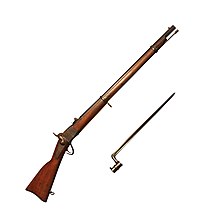Peabody action
This article needs additional citations for verification. (February 2017) |


The Peabody action was an early form of breechloading firearm action, where the heavy breechblock tilted downwards across a bolt mounted in the rear of the breechblock, operated by a lever under the rifle. The Peabody action most often used an external hammer to fire the cartridge.

History[]
The Peabody action was developed by Henry O. Peabody from Boston, Massachusetts, and was first patented on July 22, 1862. While the Peabody was not perfected in time for the American Civil War, a few were entered in the trials of 1864 with favorable reports.
Peabody carbines and rifles were made by the Providence Tool Company, Providence, Rhode Island; c. 1866–1871. The total production was, 112,000 for all models. Calibers were: .45 Peabody rimfire; .45-70 Government; .50 rimfire; 50-70; .433 Spanish; 10.4 mm rimfire Swiss. Barrel length carbine 20", rifle 33". Finish: Receiver casehardened, barrel blued, iron mountings, walnut stock.
The majority of Peabody's production was for foreign contracts, they were adopted by the militaries of Canada (3,000 pieces), Spain, Mexico, France (33,000), Romania and Switzerland (15,000) during the later 1860s. In the United States, Massachusetts purchased 2,941 rifles, Connecticut in circa 1871–72 purchased 2,000 Spanish model rifles and South Carolina in circa 1877 purchased 350 carbines.[citation needed] In 1919, Liberians received Peabody rifles through US arms sales.[1] The Liberian 600 Peabody rifles were bought from the German government (Woermann Co. they had been captured from the French army in the 1870-1871 war) with tonnes of gunpowder, 200,000 rounds of ammunition and 400 Mauser M1888 carbines in 1910 during the war with the Grebo tribe. The cost was $20,000.[2]
The Peabody rifle was one of a half dozen different rifles that took part in the 1866 Norwegian-Swedish rifle trials, where it lost out to the Remington rolling block (which became the Remington M1867 in Norwegian and Swedish service) because of its greater complexity, with more parts than the Remington design.
The Swiss gunsmith Friedrich von Martini created an action that somewhat resembled Peabody's, but incorporated a hammerless internal striker and used a toggle moved by the striker to lock the action during firing. Mated to a barrel with rifling designed by Alexander Henry, the Martini–Henry M1871 would become the British Army's standard rifle for twenty years.
See also[]
- Antique guns
References[]
- ^ Robert Kappel; Werner Korte; R. Friedegund Mascher (1986). Liberia: Underdevelopment and political rule in a peripheral society. Institut für Afrika-Kunde. p. 134. ISBN 978-3-923519-65-1.
- ^ La resistance contre la occupation colonial en region forestiere: Guinee 1800-1930, Jean Marie Dore. The prophet HARRIS and the Grebo rising, Haliburton, Gordon. Liberian Studies Journal.
Bibliography[]
- Flayderman, Norm (2001), Flayderman's guide to antique American firearms... and their values, Iola, WI, United States: Krause Publications, ISBN 0-87349-313-3
External links[]
- Rifles of Norway
- Rifles of Switzerland
- Rifles of Sweden
- Firearm actions
